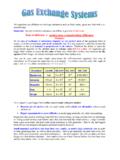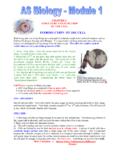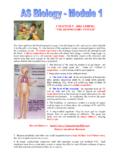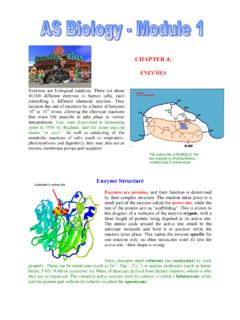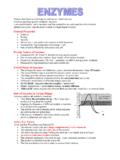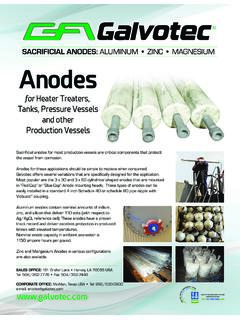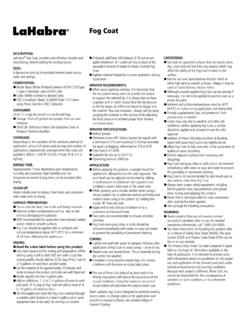Transcription of Enzyme Technology - BiologyMad
1 Enzyme Technology For thousands of years natural enzymes made by microorganisms have been used to make products such as cheese, bread, wine, and beer. enzymes are now used in a wide range of industrial processes. The study of industrial enzymes and their uses is called Enzyme Technology . The advantages and disadvantages of using enzymes are directly related to their properties: Advantages Disadvantages They are specific in their action and are therefore less likely to produce unwanted by-products They are highly sensitive to changes in physical and chemical conditions surrounding them. They are biodegradable and therefore cause less environmental pollution They are easily denatured by even a small increase in temperature and are highly susceptible to poisons and changes in pH.
2 Therefore the conditions in which they work must be tightly controlled. They work in mild conditions, low temperatures, neutral pH and normal atmospheric pressure, and therefore are energy saving The Enzyme substrate mixture must be uncontaminated with other substances that might affect the reaction. Microbes are still the most common source of industrial enzymes . Microorganisms produce enzymes inside their cells (intracellular enzymes ) and may also secrete enzymes for action outside the cell (extracellular enzymes ). The microorganisms selected are usually cultured in large fermentation chambers (known as fermenters see later) under controlled conditions to maximise Enzyme production.
3 The microorganisms may have specific genes introduced into their DNA through genetic engineering, so that they produce enzymes naturally made by other organisms - this is explained in further detail under the genetic engineering section of this unit. Jan 04 Module 2 Enzyme Technology Page 2 Growing microbes in a fermenter Given a suitable nutrient medium and the right conditions (temperature, pH, oxygen levels (many microbes are obligate anaerobes, are killed by oxygen), it is easy to grow microbes on a laboratory scale in Petri dishes, test tubes and flasks. However, producing substances such as penicillin from microbes on an industrial scale causes serious problems because massive numbers of organisms have to be grown for commercial use.)
4 The microorganisms are grown in very large vessels called fermenters as shown in this simplified diagram: The large stainless steel cavity is filled with a sterile nutrient solution, which is then inoculated with a pure culture of the carefully selected fungus or bacterium. Paddles rotate the mixture so that the suspension is mixed well. As the nutrients are used up, more can be added. Probes monitor the mixture and changes in pH, oxygen concentration and temperature are all computer controlled. A water jacket surrounding the fermenter contains fast flowing cold water to cool the fermenter since fermentation is a heat generating process.
5 Most of the air, including carbon dioxide and other gases produced by cell metabolism, leave the fermenter by an exhaust pipe. Requirements for the production of microbes in fermenters: Oxygen is needed for aerobic respiration of (some) micro-organisms others are strict anaerobes and oxygen must be excluded a source of Carbohydrate is needed as an energy source for respiration to release energy needed for growth. a source of Nitrogen is needed need nitrogen for protein synthesis Ammonia (NH3) and urea ((NH2)2CO) are both widely used as (cheap) sources of useable nitrogen Jan 04 Module 2 Enzyme Technology Page 3 Isolating the Enzyme Pure enzymes are needed for commercial use; therefore microbes must be grown in aseptic conditions, free from contaminants - such as unwanted chemicals - and other microbes.
6 It is necessary to prevent contamination with other bacteria since: there may be competition for nutrients; the required Enzyme may not be produced as readily; the end-product may be contaminated and unsafe. The required Enzyme that is finally produced must also be isolated from the microbial cells. Extracellular enzymes are present in the culture outside the microbial cells, since they have been secreted. They are often soluble in water, so they can readily be extracted from the culture medium and purified. Less common in Nature (though genetic engineering can be used to modify cells to promote this), these enzymes are cheaper to produce and tend to be more stable they are therefore the preferred choice, when available!
7 To obtain an intracellular Enzyme , the microbe cells are harvested (by filtration or centrifugation) from the culture and are then broken up. The mixture is next centrifuged to remove large cell fragments and the enzymes (all of them!) are precipitated from solution by a salt or alcohol. The required Enzyme must then be purified by techniques such as electrophoresis or column chromatography. This last process is complicated and expensive, so these enzymes are only used when no other alternative is available. By their very nature, they tend to be more sensitive to their operating conditions, which makes their commercial use less easy.
8 On the other hand, they are much more common in Nature! Table comparing intra- and extra-cellular enzymes : Intracellular enzymes Extracellular enzymes More difficult to isolate Easier to isolate Cells have to be broken apart to release them No need to break cells secreted in large amounts into medium surrounding cells Have to be separated out from cell debris and a mixture of many enzymes and other chemicals Often secreted on their own or with a few other enzymes Often stable only in environment inside intact cell More stable Purification/downstreaming processing is difficult/expensive Purification/downstreaming processing is easier/cheaper Jan 04 Module 2 Enzyme Technology Page 4 Microorganisms such as bacteria and fungi are saprobionts they feed saprophytically.
9 Secreting enzymes onto their food making them a good source of extracellular enzymes . For example, the fungus Aspergillus niger produces an Enzyme called pectinase, which breaks down pectin, a substance found in the cell walls of plant cells. The fruit juice industry uses pectin widely, since when fruit is crushed to extract the juice, pectin prevents some being released and also makes the juice cloudy. The stainless steel fermenter with complicated control systems is not actually the most expensive part of the process. Almost 80% of the cost is accounted for by downstream processing: the isolation, extraction, and purification of the product at the end of the culture in the fermenter.
10 Microbial Fermentations Int racell ular enzymes Extracell ular enzymes Liqui d/solid seperati on (achie ved by filtration or centri fugation) solids liquids cell disintegration Liqui d/solid seperati on Nucleic acid rem o va l liquids Purification Concentration Finishing PRODUCT WASTE solids Downstreaming uses a variety of techniques. In the first stage cells need to be separated from the liquid part of the suspension. This can be done by sedimentation, centrifugation or filtration. If the cells themselves are the desired product ( for single-cell protein production for animal feed) then they need to be sterilised, washed, dried and packaged. If the desired product is a chemical within the cells, the cells have to be broken apart to release the chemical and the cellular components removed.
